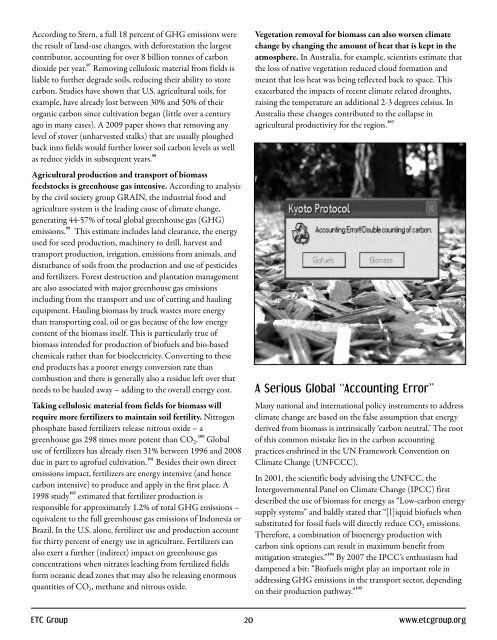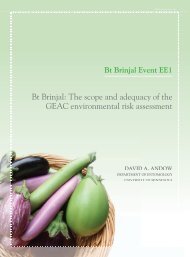English - pdf - 2145 Kb - Biosafety Information Centre
English - pdf - 2145 Kb - Biosafety Information Centre
English - pdf - 2145 Kb - Biosafety Information Centre
- No tags were found...
Create successful ePaper yourself
Turn your PDF publications into a flip-book with our unique Google optimized e-Paper software.
According to Stern, a full 18 percent of GHG emissions werethe result of land-use changes, with deforestation the largestcontributor, accounting for over 8 billion tonnes of carbondioxide per year. 97 Removing cellulosic material from fields isliable to further degrade soils, reducing their ability to storecarbon. Studies have shown that U.S. agricultural soils, forexample, have already lost between 30% and 50% of theirorganic carbon since cultivation began (little over a centuryago in many cases). A 2009 paper shows that removing anylevel of stover (unharvested stalks) that are usually ploughedback into fields would further lower soil carbon levels as wellas reduce yields in subsequent years. 98Agricultural production and transport of biomassfeedstocks is greenhouse gas intensive. According to analysisby the civil society group GRAIN, the industrial food andagriculture system is the leading cause of climate change,generating 44-57% of total global greenhouse gas (GHG)emissions. 99This estimate includes land clearance, the energyused for seed production, machinery to drill, harvest andtransport production, irrigation, emissions from animals, anddisturbance of soils from the production and use of pesticidesand fertilizers. Forest destruction and plantation managementare also associated with major greenhouse gas emissionsincluding from the transport and use of cutting and haulingequipment. Hauling biomass by truck wastes more energythan transporting coal, oil or gas because of the low energycontent of the biomass itself. This is particularly true ofbiomass intended for production of biofuels and bio-basedchemicals rather than for bioelectricity. Converting to theseend products has a poorer energy conversion rate thancombustion and there is generally also a residue left over thatneeds to be hauled away – adding to the overall energy cost.Taking cellulosic material from fields for biomass willrequire more fertilizers to maintain soil fertility. Nitrogenphosphate based fertilizers release nitrous oxide – agreenhouse gas 298 times more potent than CO 2 . 100 Globaluse of fertilizers has already risen 31% between 1996 and 2008due in part to agrofuel cultivation. 101 Besides their own directemissions impact, fertilizers are energy intensive (and hencecarbon intensive) to produce and apply in the first place. A1998 study 102 estimated that fertilizer production isresponsible for approximately 1.2% of total GHG emissions –equivalent to the full greenhouse gas emissions of Indonesia orBrazil. In the U.S. alone, fertilizer use and production accountfor thirty percent of energy use in agriculture. Fertilizers canalso exert a further (indirect) impact on greenhouse gasconcentrations when nitrates leaching from fertilized fieldsform oceanic dead zones that may also be releasing enormousquantities of CO 2 , methane and nitrous oxide.Vegetation removal for biomass can also worsen climatechange by changing the amount of heat that is kept in theatmosphere. In Australia, for example, scientists estimate thatthe loss of native vegetation reduced cloud formation andmeant that less heat was being reflected back to space. Thisexacerbated the impacts of recent climate related droughts,raising the temperature an additional 2-3 degrees celsius. InAustralia these changes contributed to the collapse inagricultural productivity for the region. 103A Serious Global “Accounting Error”Many national and international policy instruments to addressclimate change are based on the false assumption that energyderived from biomass is intrinsically ‘carbon neutral.’ The rootof this common mistake lies in the carbon accountingpractices enshrined in the UN Framework Convention onClimate Change (UNFCCC).In 2001, the scientific body advising the UNFCC, theIntergovernmental Panel on Climate Change (IPCC) firstdescribed the use of biomass for energy as “Low-carbon energysupply systems” and baldly stated that “[l]iquid biofuels whensubstituted for fossil fuels will directly reduce CO 2 emissions.Therefore, a combination of bioenergy production withcarbon sink options can result in maximum benefit frommitigation strategies.” 104 By 2007 the IPCC’s enthusiasm haddampened a bit: “Biofuels might play an important role inaddressing GHG emissions in the transport sector, dependingon their production pathway.” 105ETC Group 20 www.etcgroup.org











